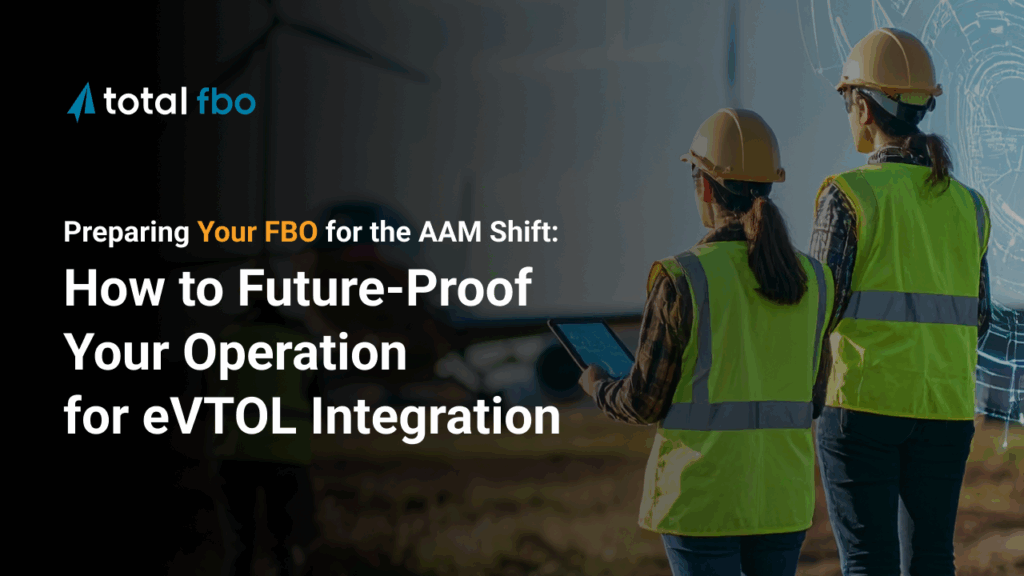Preparing Your FBO for the AAM Shift: How to Future-Proof Your Operation for eVTOL Integration

As Advanced Air Mobility (AAM) reshapes the future of aviation, Fixed–Base Operators (FBOs) are facing a fundamental shift. It’s no longer about accommodating electric aircraft—it’s about rethinking the entire ground handling model. From managing faster turnaround times and eVTOL traffic to adopting data-driven workflows, AAM-readiness demands agility, precision, and digital coordination. These are no longer future-state ambitions—they’re fast becoming operational realities.
What is AAM?
AAM refers to a new generation of aircraft and infrastructure designed to support short-range, on-demand travel — typically using electric propulsion and operating in and around cities. You’ve likely come across terms like eVTOLs (electric Vertical Take-Off and Landing aircraft) and air taxis. These technologies are undergoing real-world testing and gaining momentum across the industry.
But AAM isn’t just about a new type of aircraft — it represents a transformation in how aviation integrates with urban and regional mobility. These systems aim to reduce congestion, unlock new routes, and enable faster, quieter, lower-emission transport options.
For FBOs, this means adapting not only to technical requirements but also to entirely new expectations around responsiveness, throughput, and the flow of people and aircraft through your facility.
What AAM Means for FBOs?
The rapid advancement of AAM is turning expectations into near-term realities. FAA-led pilot programs and OEM certification efforts are accelerating the path from prototype to deployment. As eVTOL adoption inches closer, FBOs are being asked to meet a new standard — defined by faster cycles, digitally integrated workflows, reliable electric infrastructure, and a mobility-focused service model.
To meet these evolving demands, FBOs must adapt across several core areas:
- Align turnaround processes with high-frequency eVTOL operations
- Implement real-time scheduling and dispatch systems
- Install EV charging infrastructure to minimize ground time
- Establish updated safety protocols for electric propulsion systems
- Deliver seamless, digital-first experiences for crews and passengers
As regulatory frameworks evolve, FBOs will need flexible systems that can adapt to new standards around certification, safety, and sustainability. With many AAM operators being digital-first startups, expectations for speed, integration, and responsiveness will only intensify.
Key Operational Shifts to Prepare for AAM
1. Space and Infrastructure
eVTOLs operate differently from traditional fixed-wing aircraft. Their vertical takeoff and landing capabilities introduce both flexibility and complexity to your ramp operations. With shorter turnaround times and more frequent scheduling, infrastructure must become more agile.
Preparing your facility for AAM means making targeted infrastructure upgrades that enable flexibility, scalability, and compliance. This includes:
- Reconfiguring your ramp, rooftop, or adjacent spaces with dedicated vertiport pads that meet regulatory and OEM standards
- Installing EV charging stations and evaluating battery swap capabilities
- Upgrading passenger handling areas for high-throughput service, particularly for short-hop urban operations
- Developing infrastructure and workflows to support hybrid operations, where conventional and electric aircraft can coexist efficiently
2. Smarter Turnarounds and Scheduling
eVTOLs require a scheduling model more akin to ground transit than traditional aviation. With shorter flights and higher frequency, operational tempo increases dramatically.
To match this pace of AAM operations, FBOs need to elevate how they manage time-sensitive workflows. That means:
- Using real-time aircraft tracking and slot allocation to improve ramp flow
- Enabling automated service dispatch with mobile alerts for faster and more coordinated crew response
- Implementing adaptive crew scheduling systems that align staffing levels with fluctuating demand
3. Energy and Sustainability
As electric propulsion becomes a defining feature of AAM, energy management shifts from being a facilities concern to a frontline operational focus. Supporting electric aircraft at scale means having the right infrastructure, the right systems, and the foresight to balance demand with reliability.
To build resilience and efficiency into your power strategy:
- Invest in smart energy infrastructure that can forecast peak demand, reduce strain, and accommodate variable load profiles
- Track battery performance and charging cycles to prevent avoidable downtime and improve asset longevity
- Align charging schedules across aircraft and equipment to maintain consistent service flow, even during high-traffic windows
4. Safety and Training
High-voltage systems, advanced avionics, and electric propulsion introduce new safety risks that traditional protocols weren’t built to handle. Training and preparedness of your team are key.
To build confidence and capability on the ground:
- Deliver targeted training on electric systems, battery handling, and emergency scenarios
- Establish and regularly rehearse new safety protocols for thermal runaway, isolation procedures, and high-voltage shutdowns
- Keep standard operating procedures (SOPs) and training programs aligned with evolving Federal Aviation Administration (FAA) guidance and OEM requirements to ensure safety and compliance at every stage
How Software Enables AAM-Ready FBO Operations?
Adapting to the fast-paced, digitally connected world of AAM requires a management system that can scale across infrastructure, teams, and tasks. Smart FBO software plays a pivotal role in managing high-frequency eVTOL traffic, real-time crew scheduling, and digitizing operations.
A platform like total fbo enables:
- Unify Operations: Manage traditional and electric aircraft workflows from a single system, improving coordination and reducing manual handoffs.
- Accelerate Turnarounds: Use automated workflows and real-time updates to streamline service and improve ramp efficiency.
- Data-Driven Planning: Gain insights from dashboards and reports to optimize resource usage and staffing.
- Audit Readiness: Maintain clean digital records to simplify certification, regulatory compliance, and operational oversight.
Final Approach: Positioning Your FBO for the Future
AAM isn’t a distant vision—it’s an imminent shift. It’s reshaping expectations across infrastructure, scheduling, energy, and training, and the FBOs that adapt early will be best positioned to lead in this new landscape.
Whether you’re rethinking the layout of your ramp or evolving how your teams coordinate on the ground, the transition requires clarity, flexibility, and the right systems in place. total fbo can help you manage that transition by streamlining operations, ensuring compliance, and scaling new services with confidence.
Ready to future-proof your FBO?
Contact Us to learn more.





